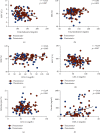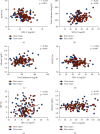Investigation of Lipid Profile and Clinical Manifestations in SCA Children
- PMID: 32884585
- PMCID: PMC7455829
- DOI: 10.1155/2020/8842362
Investigation of Lipid Profile and Clinical Manifestations in SCA Children
Abstract
Introduction: Clinical complications in sickle cell anemia (SCA) are heterogeneous and involve several molecules. It has been suggested that SCA individuals present a dyslipidemic phenotype and that lipid parameters are associated with severe clinical complications, such as pulmonary hypertension. We sought to investigate associations between lipid parameters and clinical manifestations, as well as other laboratory parameters in a population of pediatric SCA patients.
Methods: Our cross-sectional evaluation included 126 SCA patients in steady state and who were not undergoing lipid-lowering therapy. Hematological and biochemical parameters were characterized, and previous clinical manifestations were investigated.
Results: Total cholesterol and low-density lipoprotein cholesterol (LDL-C) levels were increased in patients with a previous history of pneumonia, which also positively correlated with HbS levels. Decreased LDL-C levels were also associated with leg ulcers and anemia. Elevated high-density lipoprotein cholesterol (HDL-C) levels were associated with pain crises, increased viscosity, and decreased hemolysis. Several studies have determined that lipids play a role in the vascular impairment seen in SCA, which was corroborated by our findings.
Conclusions: In sum, our results suggest that total cholesterol, HDL-C, and LDL-C levels are associated with hemolysis and anemia markers and, most importantly, with clinical complications related to vasculopathy in SCA.
Copyright © 2020 Caroline Conceição da Guarda et al.
Conflict of interest statement
The authors have not received any funding or benefits from industry companies or otherwise to conduct this study.
Figures



Similar articles
-
Higher values of triglycerides:HDL-cholesterol ratio hallmark disease severity in children and adolescents with sickle cell anemia.Braz J Med Biol Res. 2019 Oct 14;52(10):e8833. doi: 10.1590/1414-431X20198833. eCollection 2019. Braz J Med Biol Res. 2019. PMID: 31618296 Free PMC article.
-
Association of classical markers and establishment of the dyslipidemic sub-phenotype of sickle cell anemia.Lipids Health Dis. 2017 Apr 11;16(1):74. doi: 10.1186/s12944-017-0454-1. Lipids Health Dis. 2017. PMID: 28399852 Free PMC article.
-
Lipid profiles in French West Indies sickle cell disease cohorts, and their general population.Lipids Health Dis. 2018 Mar 5;17(1):38. doi: 10.1186/s12944-018-0689-5. Lipids Health Dis. 2018. PMID: 29506549 Free PMC article.
-
Effects of soy and other natural products on LDL:HDL ratio and other lipid parameters: a literature review.Adv Ther. 2003 Jan-Feb;20(1):50-78. doi: 10.1007/BF02850119. Adv Ther. 2003. PMID: 12772818 Review.
-
Update on the laboratory investigation of dyslipidemias.Clin Chim Acta. 2018 Apr;479:103-125. doi: 10.1016/j.cca.2018.01.015. Epub 2018 Jan 11. Clin Chim Acta. 2018. PMID: 29336935 Review.
Cited by
-
Homozygote drepanocytosis: Ferric status and inflammation in world and Africa: Review article and meta analysis.Health Sci Rep. 2023 Oct 4;6(10):e1609. doi: 10.1002/hsr2.1609. eCollection 2023 Oct. Health Sci Rep. 2023. PMID: 37808933 Free PMC article. Review.
-
Associations between TGF-β1 Levels and Markers of Hemolysis, Inflammation, and Tissue Remodeling in Pediatric Sickle Cell Patients.Mediators Inflamm. 2021 Mar 13;2021:4651891. doi: 10.1155/2021/4651891. eCollection 2021. Mediators Inflamm. 2021. PMID: 33790690 Free PMC article.
-
Prophylactic antibiotics for preventing pneumococcal infection in children with sickle cell disease.Cochrane Database Syst Rev. 2021 Mar 8;3(3):CD003427. doi: 10.1002/14651858.CD003427.pub5. Cochrane Database Syst Rev. 2021. PMID: 33724440 Free PMC article.
-
Lipid and hemolysis parameters predicting acute chest syndrome in adulthood with sickle cell disease.Lipids Health Dis. 2024 May 16;23(1):140. doi: 10.1186/s12944-024-02135-8. Lipids Health Dis. 2024. PMID: 38755670 Free PMC article.
-
Priapism in sickle cell disease: Associations between NOS3 and EDN1 genetic polymorphisms and laboratory biomarkers.PLoS One. 2021 Feb 4;16(2):e0246067. doi: 10.1371/journal.pone.0246067. eCollection 2021. PLoS One. 2021. PMID: 33539452 Free PMC article.
References
MeSH terms
Substances
LinkOut - more resources
Full Text Sources
Medical

